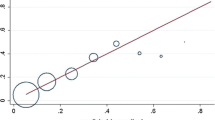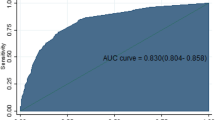Abstract
Purpose
To develop a predictive model for risk of cesarean section in pregnant women after induction of labor.
Methods
A retrospective cohort study was conducted of 861 induced labors during 2009, 2010, and 2011 at Hospital “La Mancha-Centro” in Alcázar de San Juan, Spain. Multivariate analysis was used with binary logistic regression and areas under the ROC curves to determine predictive ability. Two predictive models were created: model A predicts the outcome at the time the woman is admitted to the hospital (before the decision to of the method of induction); and model B predicts the outcome at the time the woman is definitely admitted to the labor room.
Results
The predictive factors in the final model were: maternal height, body mass index, nulliparity, Bishop score, gestational age, macrosomia, gender of fetus, and the gynecologist’s overall cesarean section rate. The predictive ability of model A was 0.77 [95 % confidence interval (CI) 0.73–0.80] and model B was 0.79 (95 % CI 0.76–0.83). The predictive ability for pregnant women with previous cesarean section with model A was 0.79 (95 % CI 0.64–0.94) and with model B was 0.80 (95 % CI 0.64–0.96). For a probability of estimated cesarean section ≥80 %, the models A and B presented a positive likelihood ratio (+LR) for cesarean section of 22 and 20, respectively. Also, for a likelihood of estimated cesarean section ≤10 %, the models A and B presented a +LR for vaginal delivery of 13 and 6, respectively.
Conclusion
These predictive models have a good discriminative ability, both overall and for all subgroups studied. This tool can be useful in clinical practice, especially for pregnant women with previous cesarean section and diabetes.


Similar content being viewed by others
References
Sociedad Española de Ginecología y Obstetricia. Inducción de parto. Protocolos prosego 2013. http://www.prosego.es
Health and Care of Pregnant Women and Babies in Europe in 2010. European Perinatal Health Report 2014:90–92. http://www.europeristat.com/reports/european-perinatal-health-report-2010.html
Caughey AB, Sundaram V, Kaimal AJ et al (2009) Maternal and neonatal outcomes of elective induction of labour. Evid Rep Technol Assess (Full Rep) 176:1–257
Guerra GV, Cecatti JG, Souza JP et al (2009) Factors and outcomes associated with the induction of labour in Latin America. BJOG 116(13):1762–1772
Janakiraman V, Ecker J, Kaimal AJ (2010) Comparing the second stage in induced and spontaneous labor. Obstet Gynecol 116(3):606–611
Selo-Ojeme D, Rogers C, Mohanty A, Zaidi N, Villar R, Shangaris P (2011) Is induced labour in the nullipara associated with more maternal and perinatal morbidity? Arch Gynecol Obstet 284(2):337–341
Al-Shaikh G1, Al-Mandeel H (2013) The outcomes of trial of labour after cesarean section following induction of labour compared to spontaneous labour. Arch Gynecol Obstet 287(6):1099–1103
Rossi AC, Prefumo F (2015) Pregnancy outcomes of induced labor in women with previous cesarean section: a systematic review and meta-analysis. Arch Gynecol Obstet 291(2):273–280
Ehrenthal DB, Jiang X, Strobino DM (2010) Labor induction and the risk of a cesarean delivery among nulliparous women at term. Obstet Gynecol 116(1):35–42
Allen VM, O’Connell CM, Baskett TF (2006) Maternal morbidity associated with cesarean delivery without labour compared with induction of labour at term. Obstet Gynecol 108(2):286–294
Hatfield AS, Sanchez-Ramos L, Kaunitz AM (2007) Sonographic cervical assessment to predict the success of labour induction: a systematic review with met analysis. Am J Obstet Gynecol 197(2):186–192
Verhoeven CJ, Opmeer BC, Oei SG, Latour V, van der Post JA, Mol BW (2013) Transvaginal sonographic assessment of cervical length and wedging for predicting outcome of labour induction at term: a systematic review and meta-analysis. Ultrasound Obstet Gynecol 42(5):500–508
Cheung CW, Leung TY, Sahota DS et al (2010) Outcome of induction of labour using maternal characteristics, ultrasound assessment and biochemical state of the cervix. J Matern Fetal Neonatal Med 23(12):1406–1412
Cnattingius R, Hoglund B, Kieler H (2005) Emergency cesarean delivery in induction of labour: an evaluation of risk factors. Act Obstet Gynecol Scand 84(5):456–462
Gomez-Laencina AM, Garcia CP, Asensio LV, Ponce JA, Martinez MS, Martinez-Vizcaino V (2012) Sonographic cervical length as a predictor of type of delivery after induced labour. Arch Gynecol Obstet 285(6):1523–1528
Isono W, Nagamatsu T, Uemura Y et al (2011) Prediction model for the incidence of emergent cesarean section during induction of labour specialized in nulliparous low-risk women. J Obstet Gynaecol Res 37(12):1784–1791
Peregrine E, O’Brien P, Omar R, Jauniaux E (2006) Clinical and ultrasound parameters to predict the risk of cesarean delivery after induction of labour. Obstet Gynecol 107(2 Pt 1):227–233
Rane SM, Guirgis RR, Higgins B, Nicolaides KH (2005) Models for the prediction of successful induction of labour based on pre-induction sonographic measurement of cervical length. J Matern Foetal Neonatal Med 17(5):315–322
Rane SM, Guirgis RR, Higgins B, Nicolaides KH (2004) The value of ultrasound in the prediction of successful induction of labour. Ultrasound ObstetGynecol 24(5):538–549
Smith GC, Dellens M, White IR, Pell JP (2004) Combined logistic and Bayesian modelling of cesarean section risk. Am J Obstet Gynecol 191(6):2029–2034
Pitarello PR, Tadashi YC, Ruano R, Zugaib M (2013) Prediction of successful labour induction using transvaginal sonographic cervical measurements. J Clin Ultrasound 41(2):76–83
Hosmer DW, Lemeshow S (2000) Applied logistic regression, 2nd edn. Willey, New York
Verhoeven CJ, Oudenaarden A, Hermus MA, Porath MM, Oei SG, Mol BW (2009) Validation of models that predict Cesarean section after induction of labour. Ultrasound Obstet Gynecol 34(3):316–321
Bertossa P, Novakov MA, Stupar ZT et al (2012) Validity of clinical and ultrasound variables to predict the risk of cesarean delivery after induction of labour. Obstet Gynecol 120(1):53–59
Kolkman DG, Verhoeven CJ, Brinkhorst SJ et al (2013) The bishop score as a predictor of labour induction success: a systematic review. Am J Perinatol 30(8):625–630
Leduc D, Biringer A, Lee L et al (2013) Induction of labour. J Obstet Gynaecol Can 35(9):840–857
Agarwal U, Anastasakis E, Kadir RA (2009) The effect of foetal sex on the outcome of labour induction. J Obstet Gynaecol 29(8):711–713
Eogan MA, Geary MP, O’Connell MP, Keane DP (2003) Effect of foetal sex on labour and delivery: retrospective review. BMJ 326(7381):137
Schuit E, Kwee A, Westerhuis ME et al (2012) A clinical prediction model to assess the risk of operative delivery. BJOG 119(8):915–923
Althabe F, Sosa C, Belizan JM, Gibbons L, Jacquerioz F, Bergel E (2006) Cesarean section rates and maternal and neonatal mortality in low-, medium-, and high-income countries: an ecological study. Birth 33(4):270–277
Declercq E, Young R, Cabral H, Ecker J (2011) Is a rising cesarean delivery rate inevitable? Trends in industrialized countries, 1987 to 2007. Birth 38(2):99–104
Grupo de variaciones en la práctica médica. Variaciones en la utilización de la cesárea en los hospitales públicos del Sistema Nacional de Salud. Documento de trabajo 04-2009. 2009
Author information
Authors and Affiliations
Corresponding author
Ethics declarations
Conflict of interest
The authors declare that there are no conflicts of interest and that this study has been conducted with no funding.
Rights and permissions
About this article
Cite this article
Hernández-Martínez, A., Pascual-Pedreño, A.I., Baño-Garnés, A.B. et al. Predictive model for risk of cesarean section in pregnant women after induction of labor. Arch Gynecol Obstet 293, 529–538 (2016). https://doi.org/10.1007/s00404-015-3856-1
Received:
Accepted:
Published:
Issue Date:
DOI: https://doi.org/10.1007/s00404-015-3856-1




